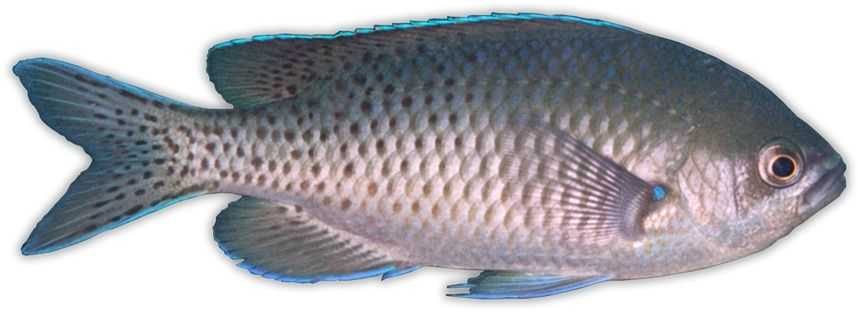Blacksmith

Species Details
Chromis Punctipinnis
Pomacentridae
Perciformes
Onshore, Nearshore, Shallows, Rocky, Reef
1 - 2 lbs.
6" - 10"
Blacksmith (Chromis punctipinnis) Fish Description
Also known as Blacksmith Chromis, Black Perch, Blue Perch or Blacksmith Damselfish, the Blacksmith belongs to the damselfish family. In Mexico they are known as Castañeta Herrera.
This fish is blue-black in color; black spots can be found towards the Blacksmith’s tail. It has large scales and possesses a forked tail. The Blacksmith’s young have a blue-grey front and a brownish-orange rear.
Blacksmith Diet and Size
Blacksmiths feed on plankton, more specifically zooplankton. They also feast on various small species in the area like copepods, the eggs and larvae of other marine organisms.
Blacksmiths reach a maximum of 30.5 cm (12.0 inches); however, a majority of them grow up to only 10-20 cm (4-8 in) long.
Interesting Facts About Blacksmith
- Blacksmiths spawn in the summer and autumn months. They are believed to be sexually mature at about two years when they are over 13 cm (5 in) long.
- The Blacksmith has a symbiotic relationship to the fish species, Senorita (Oxujulis californica). This works by letting the Senorita clean their bodies, ridding them of external parasites harming the Blacksmith.
- These fish are very sociable. They make up big schools, typically swimming in open water well above the ocean bottom, feeding on plankton. It is reported that they migrate to rocky holes before sunset where they stay for the night. Those unable to instead find a hole cluster in dense schools near the rocks.
- Male Blacksmiths clean a nesting site, then take a female toward it. Then, after spawning, the male guards the eggs and aerates them. The males guarding the nests change color from blue to an almost white color with a dark band around the eyes. The eggs are demersal, which means they are located near the bottom of the seas, known as the demersal zone.
- Larvae of Blacksmith are mostly found within 160 km (100 mi) of shore. Juveniles form schools in late summer and early fall. They are semi-pelagic but are often observed to be residing in kelp beds.
Blacksmith Fishing Techniques
This fish is a common catch by anglers near the rocky shores in southern California. Size 6 to 8 hooks work best when angling on the bottom to mid-depth. The recommended baits for the Blacksmith are live bloodworms, lugworms, or small pieces of shrimp and squid.
Since Blacksmith are found inshore, look for them in kelp forests, rocky reefs, and steep banks as deep as 61 m or 200 feet. Note that they are also abundant in piers, oil platforms, docks, bridge pilings, and other manmade structures.
Blacksmith Habitat & Distribution
Blacksmiths are native to the areas around the Northeastern Pacific Ocean ranging from Monterey Bay, California, USA to Central Baja California, Mexico.
The Blacksmith is a demersal species which means that it is found at depths up to 61 m (200 feet). They are mainly an inshore fish, often visiting man-made structures like, oil platforms, docks, and piers. It is mostly associated with rocky reefs and forests of kelp. They usually stay close to the sea floor, on rocks and slops, and kelp forests. The juveniles use kelp beds for a habitat.







